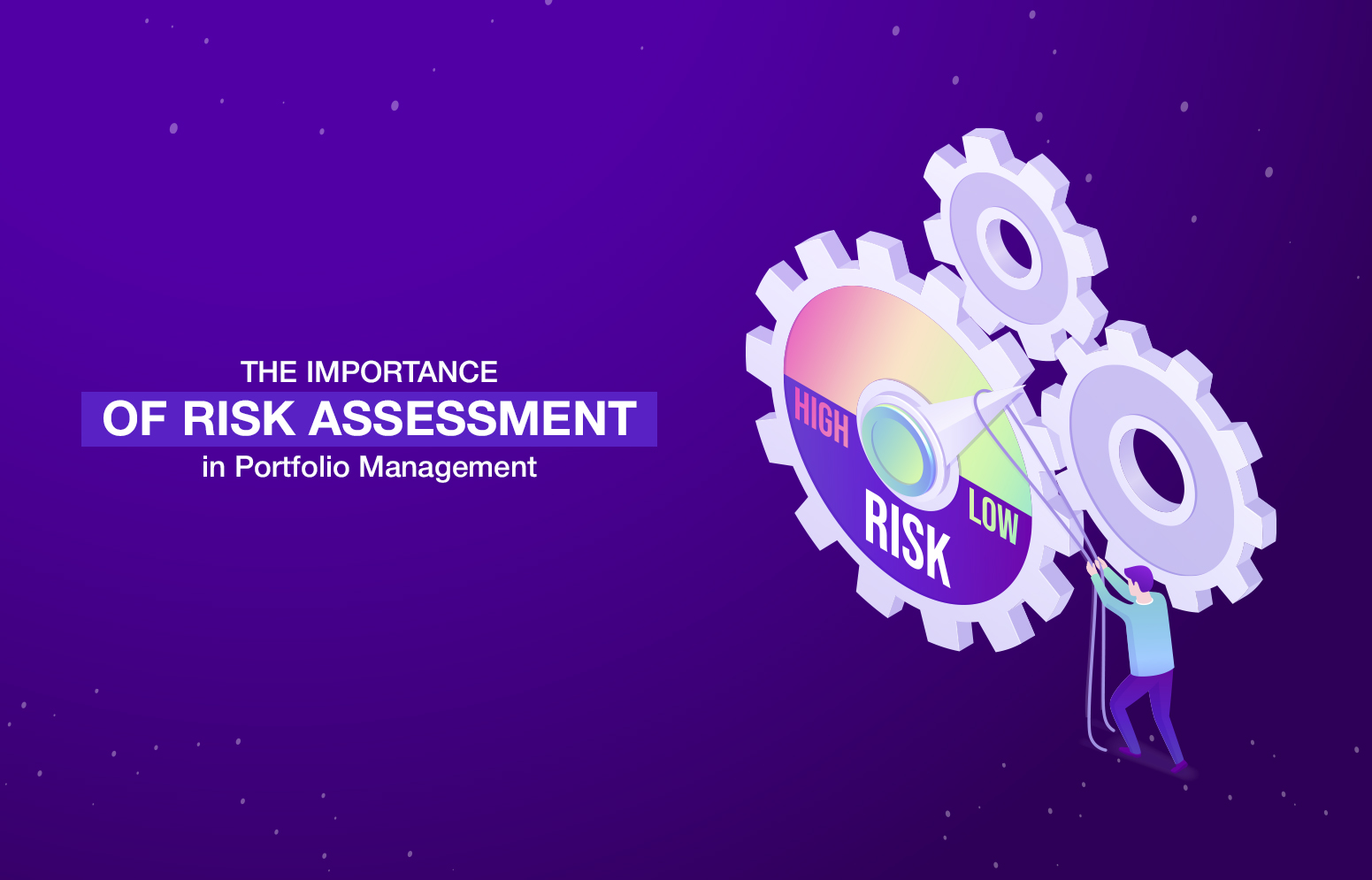Table of Contents
Introduction
Risk assessment is a systematic process used to recognize, analyze, and control hazards and risks existing in a given situation or location. In the context of investment portfolios, understanding and managing various types of risks associated with your investments is crucial for achieving your investment goals.
A key benefit of risk assessment is its ability to help investors make informed decisions by considering both potential gains and losses. By keenly analyzing the future outcomes in terms of financial returns, losses, or disruptions, investors can tailor their investment strategies to mitigate risks while maximizing returns.
In general terms, the more risk you are willing to take, the higher the potential returns. Inversely, the possibility of losing your investment also becomes significantly higher.
Therefore, determining your risk tolerance, return expectations, and investment timeline is crucial for building a healthy portfolio.
Let’s now deep-dive into different types of investment risks, ways to minimize these risks, the various risk profiles investors may fall into, and how a financial expert can conduct a risk assessment to suggest the best investments according to an investor’s need.
Different Types of Investment Risks
- Market Risk (Systematic Risk): This risk arises from overall market movements. Factors such as economic conditions, geopolitical events, and interest rate changes impact the entire market, which leads to the decline of investment value. For eg – in 2016 within two weeks of the Indian government announcing demonetization, Nifty 50 had fallen by 6.34%.
- Liquidity Risk: Liquidity risk arises when an investor faces difficulty selling an investment due to low trading volumes or a lack of buyers in the market. This is a bigger concern with assets that are hard to sell quickly- think real estate. This can lead to losses, especially when the market is down.
- Concentration Risk: Concentration risk occurs when an investor heavily invests in a single asset or sector, increasing the potential for significant losses. This risk can be mitigated by diversifying investments across different asset classes, which helps spread risk and reduce potential losses.
- Credit Risk: Also known as default risk, credit risk refers to the possibility that an issuer (e.g., a company or government) will fail to meet its debt obligations. This risk is prevalent in investments involving bonds or other debt securities.
- Reinvestment Risk: Reinvestment risk arises when interest rates fall, affecting the reinvestment of coupon payments or maturing investments and reducing potential overall returns. For instance, if an investor holds a bond paying 6% interest and it matures when the interest rate has dropped to 4%, reinvesting the proceeds at the lower rate will yield lower returns, resulting in loss of potential earnings.
- Longevity Risk: Longevity risk is the risk of outliving your retirement savings. For example, if someone retires at 65 and plans for their savings to last until they’re 85, but ends up living until 95, they may face a shortfall in their retirement funds. To mitigate this risk, it’s crucial to consider investments that offer a steady income stream for an extended period.
- Inflation Risk: Inflation risk is the danger that rising prices will erode the purchasing power of your money over time. For example, if you save Rs 100 today, it might buy fewer goods in the future due to inflation. This means your savings could lose value, and your investment returns may not keep up with increasing costs. To combat this, one must consider investing in assets that typically outpace inflation, like stocks or real estate.
- Horizon Risk: Horizon risk is the uncertainty that an investor’s investment time frame may shorten unexpectedly, forcing them to sell investments earlier than planned. This can be due to unforeseen events like job loss, medical emergencies, or major life changes. Selling investments prematurely may result in losses or lower returns, as the market may not have had enough time to recover from downturns or to generate expected gains.
- Foreign Exchange or Currency Risk: Fluctuating exchange rates can impact the value of investments in foreign currencies. This risk affects all financial instruments held in a currency other than your domestic one. Profits from foreign investments may be reduced or wiped out when converted to domestic currency if exchange rates have changed unfavorably.
How to Mitigate these Risks when Investing?
During your investment journey, understanding risk assessment and how to manage expected and unexpected risks is crucial for a healthy future of your investments. This process commonly includes 3 steps.
- Risk Assessment and Measurement: This step involves understanding and measuring the risks that could affect your investments. For instance, imagine you’re deciding whether to invest in a company’s stock. It’s important to consider how much the stock’s price can change as per market conditions. There are various tools and measures that can be used for this purpose, such as value at risk (VaR), standard deviation, beta etc
- Risk Mitigation Strategies: Risk mitigation strategies are aimed at reducing the impact of identified risks on your portfolio. These strategies include diversification, adjusting asset allocation, hedging, and rebalancing.
- Risk Monitoring and Review: Regularly checking the risk levels of your portfolio and the effectiveness of your risk management strategies is essential. This helps you make informed decisions and adjust your strategies and investments as needed.
Diversification, asset allocation, hedging, and rebalancing play key roles in managing investment risks. By carefully planning these strategies to align with your financial goals, you can mitigate many of the risks associated with investing.
However, assessing the risks connected to different investments can be challenging, especially for working professionals. It requires time to understand the risks and stay updated about financial news and geopolitical events that can affect the market.
Therefore, seeking the help of a certified financial expert for risk assessment and building a portfolio that suits your financial goals is often the best approach.

How Financial Experts Help in Risk Assessment and Building a Strong Portfolio
Certified financial experts play a pivotal role in navigating the complexities of risk assessment and making informed investment decisions. Their expertise is instrumental in analyzing risks and crafting prudent investment strategies. Here’s a closer look at how they contribute to building a strong portfolio.
Risk Profiling
Risk profiling is a fundamental step in the process of financial planning, allowing experts to tailor investment strategies to individual risk appetites and financial goals. By evaluating factors such as risk tolerance, financial objectives, and investment horizon, experts categorize investors into three main profiles.
- Conservative: Suited for risk-averse individuals who want to avoid losses, especially applicable for those in early financial stages, with debt, or nearing retirement.
- Moderate: Ideal for those willing to take some risk for potentially higher returns, typically in the middle financial stages with some savings.
- Aggressive: Geared towards individuals comfortable with high risk, willing to potentially lose significant amounts for higher returns, often far from retirement, debt-free, and with substantial savings.
Indeed, within each risk profile category, there is no one-size-fits-all investment package. Each person’s financial situation, goals, and risk tolerance are unique, requiring a customized approach to portfolio construction. Financial experts carefully analyze the risk profile and individual preferences to craft tailored investment strategies.
Diversification and Asset Allocation
After finding your risk profile and your financial goals – whether it’s short-term or long-term, the expert allocates investments across different asset classes (stocks, bonds, real estate, etc.)
Due Diligence
Financial experts conduct thorough research on investment opportunities and analyze financial statements, industry trends, and risk factors. They will be well aware of the financial market, the connection with the market and various geopolitical events. This gives them a sense of future risks and potential returns on certain investments that may be unseen by a normal retail investor.
Risk-Adjusted Returns
Financial experts assess potential investment returns in relation to the associated risks. It’s not merely about maximizing returns; it’s about finding the right balance between risk and reward.
Rebalancing
Rebalancing involves periodically adjusting the portfolio’s asset allocation to maintain the desired risk level and return potential. For example, if an investor’s target allocation is 60% stocks and 40% bonds, and a market rally causes the stock portion to increase to 70%, rebalancing would involve selling some stocks and purchasing bonds to restore the original 60/40 allocation.
Behavioral Finance
Understanding investor behavior is crucial for financial experts. Emotions often drive investment decisions, leading to impulsive actions during market volatility. Experts help clients stay disciplined, avoid herd mentality, and make rational choices based on long-term objectives rather than short-term market fluctuations.
Hedging
Hedging involves using financial instruments like derivatives, options, or other investment strategies to protect against the risk of adverse price movements in a portfolio. This strategy aims to reduce potential losses by offsetting them with gains in another investment. For instance, purchasing a put option can act as a hedge against a stock’s decline. If the stock price falls, the put option’s value increases, offsetting losses in the stock. A financial expert can suggest to decide to use this hedging technique – when and to which.
Why Risk Assessment Is Unavoidable and Expert Guidance Is Essential
The financial market in India, like elsewhere, is subject to the influence of both expected and unexpected events, which can have significant impacts, both positive and negative.
For instance, the outbreak of COVID-19, which originated in December 2019 in China and quickly spread globally, had a profound effect on the Indian stock market. On March 23, 2020, the Nifty 50 fell by 12.98%, marking its lowest point in four years.
This dramatic downturn highlighted the importance of diversifying across different asset classes. By holding a mix of stocks, bonds, real estate, and other asset types, investors can protect their portfolios from the severe impacts of market-wide disruptions.
Similarly, events like the Nirav Modi case have demonstrated how unforeseen circumstances can adversely affect investors. The fraudulent scheme involving Nirav Modi and associates, which resulted in siphoning off ₹14,000 crores from Punjab National Bank (PNB) through fraudulent Letters of Undertaking (LoUs), led to a sharp decline in PNB’s stock price, eroding investors’ wealth by approximately ₹8,077 crores.
The Nirav Modi case also highlighted the significant value of diversifying within equities. For instance, had a retail investor not diversified their portfolio and instead invested solely in PNB stock, they would have suffered significant losses. PNB’s stock price, which was over ₹190 in January 2018, plummeted to below ₹100 by March 2018, representing a nearly 50% loss in just two months.
The financial markets and individual companies may not always follow a linear path, and returns may not be consistently positive. Various factors, including uncertainties, events, and internal issues within companies, can significantly impact their value. This is where risk assessment and mitigation strategies play a crucial role.
For instance, during the crisis involving Punjab National Bank (PNB), if a retail investor had a diversified portfolio and maintained a clear asset allocation strategy, the damage could have been mitigated, even if the investor had PNB stock in their portfolio.
Moreover, expert guidance is invaluable during such a crisis. A financial expert could have acted rationally in the face of the news outbreak regarding PNB, potentially saving the investor from losing a drastic amount of money. They have the knowledge and experience to navigate turbulent market conditions and make informed decisions to protect and grow their clients’ investments.
Need the help of a financial expert to assist you in your investment journey? Whether you’re a seasoned investor or just starting, you can get free personalized investment suggestions from an AMFI-registered mutual fund distributor and boost your investment journey through moolaah.com.
Let your money grow with expert guidance.





